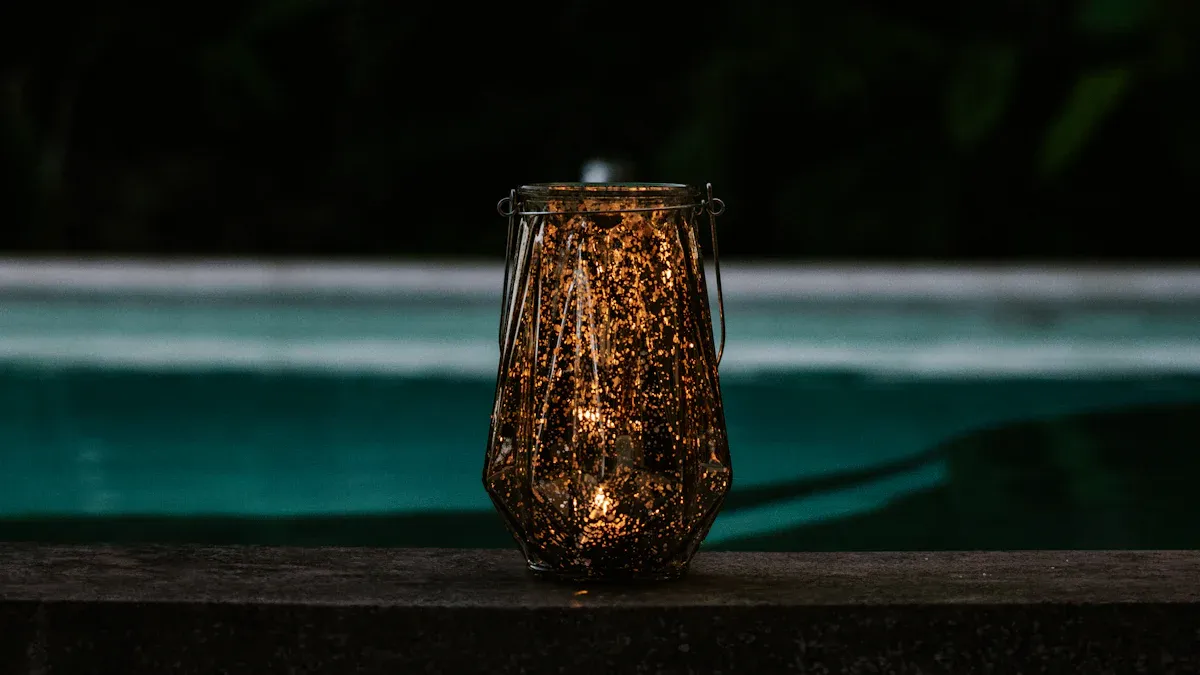
Waterproof Lighting blocks water from entering and damaging internal components, while water-resistant lighting only slows water penetration. People must understand these differences to prevent electrical hazards and select products that protect their space. Choosing the right lighting safeguards property and ensures long-lasting performance.
Key Takeaways
- Waterproof lighting fully blocks water and dust, making it perfect for wet or harsh environments like pools and outdoor areas.
- Water-resistant lighting offers limited protection and suits places with occasional splashes, such as covered porches or garages.
- Check the IP rating to match lighting with your space; higher ratings mean better protection against water and dust.
Waterproof Lighting, Water-Resistant, and Vapor-Proof: What Do They Mean?
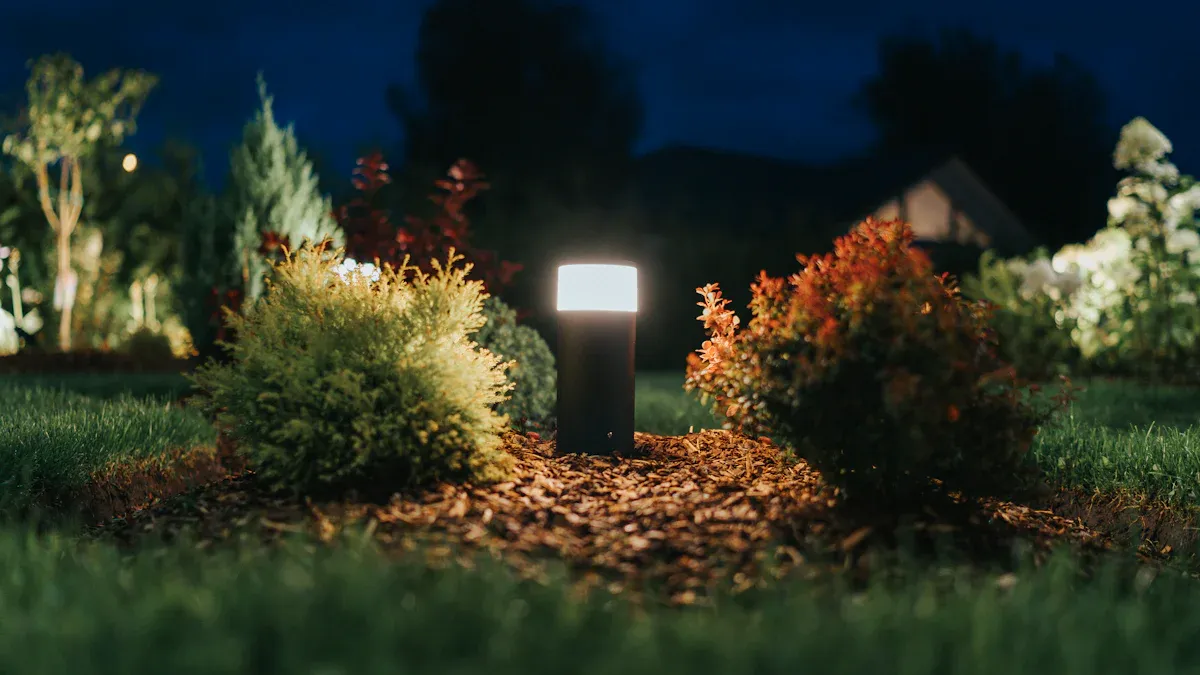
Waterproof Lighting Explained
Waterproof Lighting provides complete protection against water ingress, making it ideal for harsh and wet environments. Manufacturers use advanced materials and construction methods to achieve this level of defense.
- Silicone and EPDM gaskets seal all entry points.
- Polyurethane sealants bond components securely.
- Housings often use marine-grade 316L stainless steel or powder-coated aluminum for corrosion resistance.
- Overmolded joints, internal potting compounds, and conformal coatings protect sensitive electronics.
- Double-seal designs and pressure equalization vents prevent leaks and condensation.
- UV-stabilized polycarbonate or borosilicate glass lenses resist environmental damage.
These features ensure long-lasting performance even in submerged or high-pressure water conditions. The IP rating system helps identify the degree of protection. For example, IP65 and IP67 ratings indicate strong resistance to water jets and temporary immersion.
| IP Rating | Protection Against Dust | Protection Against Water | Typical Applications / Significance |
|---|---|---|---|
| IP65 | Total dust ingress | Low-pressure water jets | Outdoor, bathrooms, wet areas |
| IP67 | Total dust ingress | Immersion up to 1m | Pools, fountains, submerged use |
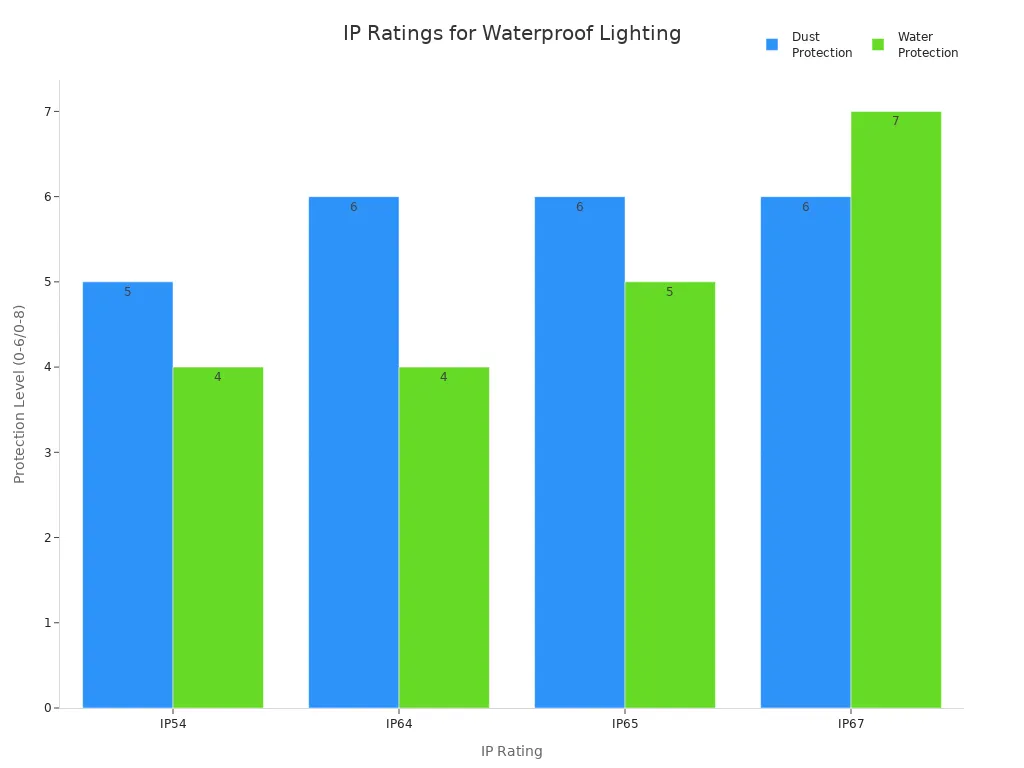
Water-Resistant Lighting Explained
Water-resistant lighting offers limited protection against moisture. These fixtures use basic sealing methods and lower-grade materials. They may include simple gaskets or splash guards but lack the comprehensive sealing found in waterproof options.
- Typical IP ratings range from IP44 to IP65.
- Suitable for areas with occasional splashes or humidity, such as covered porches or semi-sheltered outdoor spaces.
| IP Rating | Protection Level Against Moisture | Typical Applications |
|---|---|---|
| IP44 | Splash protection | Covered porches |
| IP65 | Low-pressure water jets | Damp indoor/outdoor |
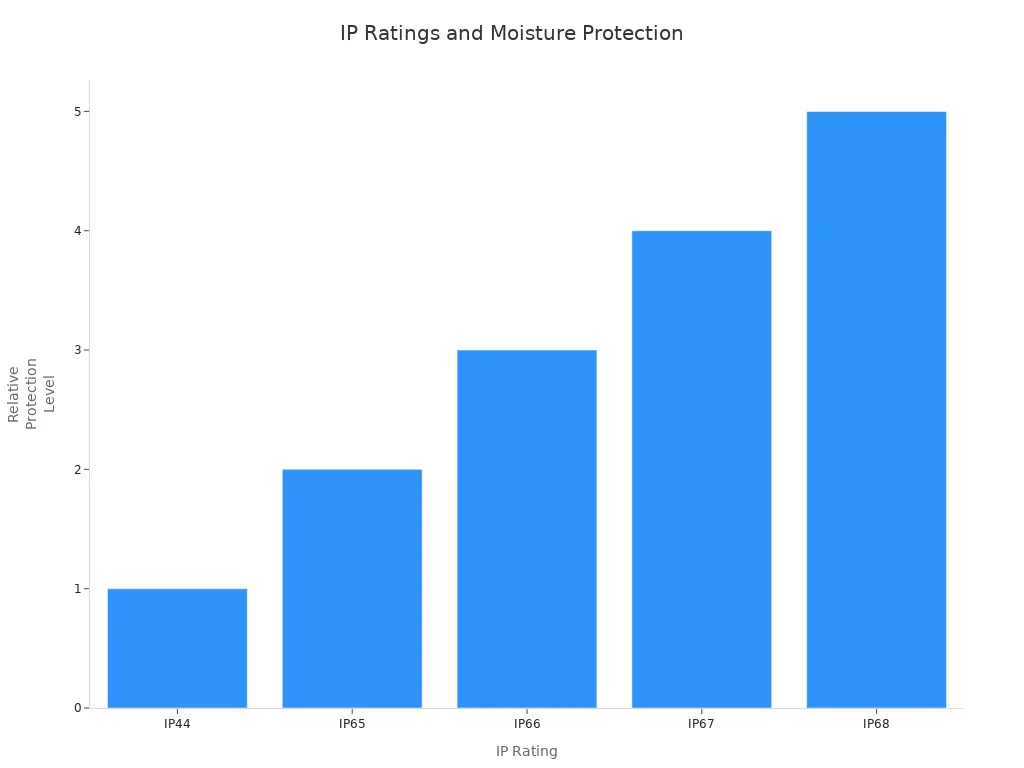
Note: Water-resistant lighting should not be used in locations with direct or prolonged water exposure.
Vapor-Proof Lighting Explained
Vapor-proof lighting protects against moisture vapor, dust, and water. These fixtures use airtight enclosures with durable materials such as polycarbonate, glass, and metal.
- Gaskets and seals prevent vapor and dust from entering.
- Impact-resistant and shatter-resistant lenses enhance safety.
- Corrosion-resistant finishes extend lifespan.
- Regular inspection of seals ensures ongoing protection.
Vapor-proof lights excel in high-humidity or chemical environments, such as car washes, spas, and industrial plants. They outperform standard waterproof or water-resistant lights in areas where vapor penetration is a concern.
Comparing Waterproof Lighting, Water-Resistant, and Vapor-Proof Options
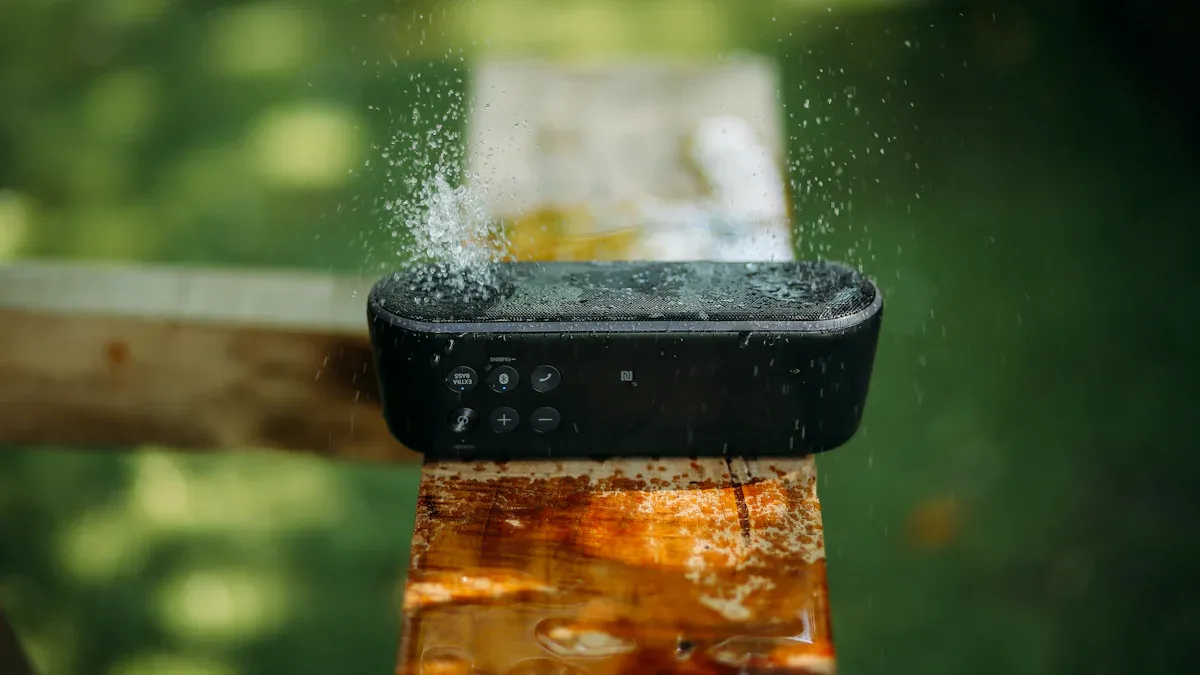
Key Differences at a Glance
Lighting solutions differ in their ability to withstand water, dust, and vapor. The main distinctions appear in their construction, level of protection, and intended use. The table below summarizes the most important differences, including cost comparisons for similar applications:
| Lighting Type | Typical IP Rating | Construction Features | Price Range (Discounted) | Common Use Cases |
|---|---|---|---|---|
| Waterproof Lighting | IP65, IP67 | Sealed gaskets, corrosion-resistant | $99–$175 | Outdoor, submerged, industrial |
| Vapor-Proof | IP66 | Airtight, impact-resistant, bug proof | $85 | Car washes, tunnels, freezers |
| Water-Resistant | IP44–IP65 | Basic seals, splash guards | N/A | Garages, patios, covered spaces |
Note: Pricing for water-resistant lighting varies widely and often costs less than waterproof or vapor-proof options, but may not provide adequate protection in harsh environments.
Real-World Performance and Durability
Waterproof Lighting stands out in environments with direct water exposure or risk of submersion. Manufacturers design these fixtures to block water and dust, ensuring reliable operation in outdoor, industrial, and underwater settings. The robust construction and high IP ratings (such as IP65 and IP67) allow these lights to withstand rain, splashes, and even temporary immersion.
Vapor-proof lighting excels in locations with high humidity, dust, or chemical vapors. These fixtures feature sealed housings that prevent vapor and dust ingress, reducing maintenance needs and extending lifespan. In cold environments, LED vapor-proof lights maintain brightness, while traditional fluorescent bulbs may dim. The sealed design also prevents bugs and debris from entering, making them ideal for car washes, tunnels, steam showers, and walk-in freezers.
Water-resistant lighting provides basic protection against splashes and moisture. These fixtures work well in areas with occasional water contact, such as garages, patios, or covered outdoor spaces. However, they may not withstand prolonged exposure or submersion. The IP rating, especially the second digit, indicates the level of moisture protection. For example, an IP65 rating means the fixture is dust-tight and can resist low-pressure water jets, making it suitable for outdoor parking lots or semi-sheltered areas.
- Vapor-proof and waterproof fixtures offer superior durability in extreme weather and industrial environments.
- Water-resistant lights suit less demanding conditions, where only occasional splashes or humidity occur.
- The right choice depends on the environment and the level of exposure to water, dust, or vapor.
Common Use Cases and Best Environments
Selecting the appropriate lighting protection ensures safety, longevity, and optimal performance. Each type of lighting serves specific environments and applications:
- Waterproof Lighting
- Residential: Gardens, swimming pools, fountains, and outdoor landscapes.
- Commercial: Security lighting, signage, and task lighting in warehouses and factories.
- Automotive and Marine: Boat and yacht lighting, navigation, and safety.
- Other: Bathrooms, kitchens, patios, and any area exposed to direct water or heavy moisture.
- Vapor-Proof Lighting
- Industrial: Car washes, tunnels, steam showers, walk-in freezers, and garages.
- Commercial: Food production areas, clean rooms, and environments with high humidity or chemical exposure.
- Utility: Utility shop lights, bug-proof and weatherproof fixtures for demanding locations.
- Water-Resistant Lighting
- Residential: Garages, patios, and covered porches.
- Commercial: Parking lots, spas, and areas with occasional water splashes.
- Other: Locations where lighting faces humidity or light splashing but not full submersion.
Tip: Always check the IP rating to match the lighting solution to the specific environment. The first digit indicates dust protection, while the second digit shows moisture resistance. Higher numbers mean greater protection.
By understanding these differences, users can select the right lighting for their needs, ensuring safety and durability in any setting.
How to Choose the Right Lighting Protection
Understanding IP Ratings
The IP (Ingress Protection) rating system helps users identify how well a lighting fixture resists dust and water. Each IP rating contains two digits. The first digit shows protection against solids, such as dust or fingers, while the second digit indicates resistance to liquids, like rain or immersion.
| Digit Position | Meaning | Range and Description |
|---|---|---|
| First Digit | Protection against solid objects | 0: No protection; 1-6: Increasing protection; 6: Complete protection |
| Second Digit | Protection against liquids | 0: No protection; 1-8: Increasing water protection; 8: Immersion |
The letter "X" replaces a digit if that type of protection is not tested, such as IPX4.
Selecting the Right Level of Protection
Choosing the correct lighting protection depends on the environment and exposure level. For outdoor or wet locations, higher IP ratings are essential. The table below summarizes minimum recommendations for common areas:
| Area | Minimum IP Rating | Notes |
|---|---|---|
| Bathrooms | IP44–IP65 | IP65 for lights above showers or bathtubs |
| Kitchens | IP44–IP65 | IP65 for fixtures above sinks |
| Outdoor Areas | IP65 | Withstands weather, dust, and water jets |
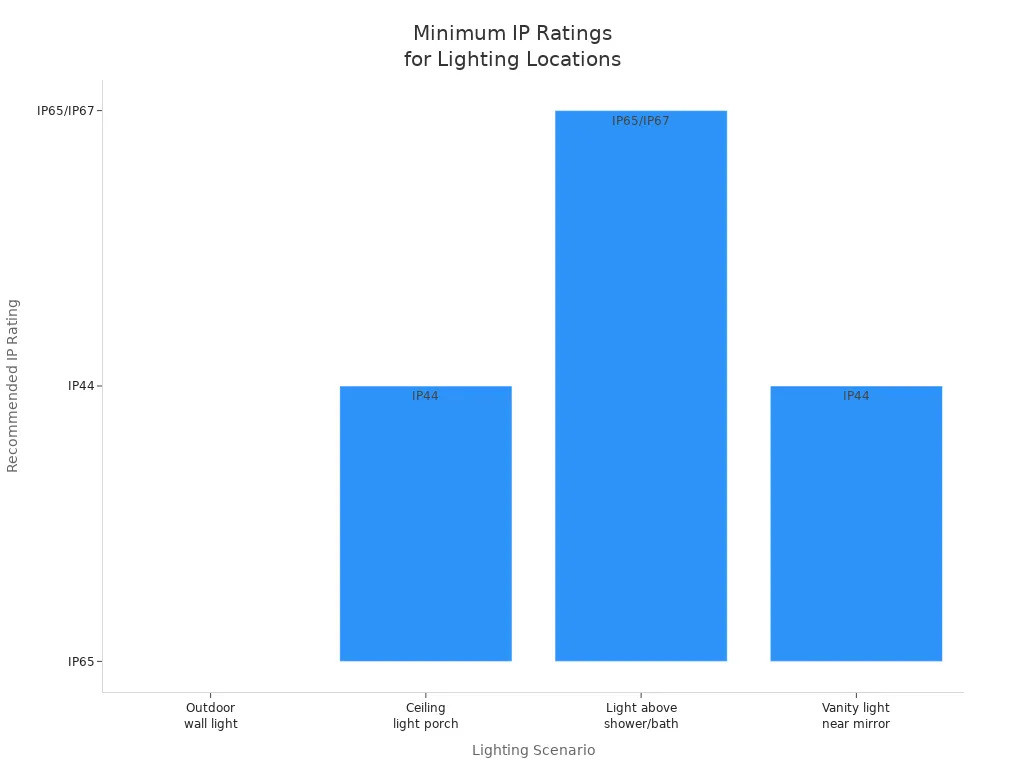
When selecting between water-resistant, vapor-proof, and Waterproof Lighting, users should consider the level of exposure, application, IP rating, materials, installation needs, and budget.
Safety and Installation Tips
Proper installation and maintenance ensure lighting safety and performance.
- Install outdoor fixtures on dedicated circuits to prevent overloads.
- Use waterproof connectors and seal all wiring to block moisture.
- Hire professional electricians for installation and inspections.
- Regularly check for damage, corrosion, or loose connections.
- Select impact-resistant fixtures for areas with debris or high winds.
Improper installation, such as using the wrong fixture or neglecting maintenance, can lead to water ingress, corrosion, and electrical hazards.
Industry standards use the IP rating system to distinguish waterproof, water-resistant, and vapor-proof lighting. Buyers should match lighting to the environment, considering durability, efficiency, and compliance. Reliable sources like manufacturer pages and expert guides help verify product specifications and ensure safe, long-lasting installations.
FAQ
What does an IP67 rating mean for lighting?
An IP67 rating means the fixture resists dust and can withstand immersion in water up to 1 meter for 30 minutes. This rating suits outdoor and submerged applications.
Can water-resistant lights be used in bathrooms?
Water-resistant lights with at least an IP44 rating work for most bathroom areas. For zones near showers or tubs, higher ratings like IP65 provide better safety.
How often should vapor-proof lighting be inspected?
Professionals recommend inspecting vapor-proof lighting every six months. Regular checks help maintain seal integrity and ensure optimal performance in demanding environments.
Post time: Jul-09-2025